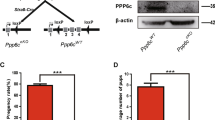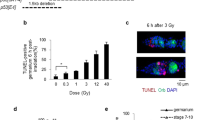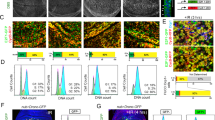Abstract
Cell cycle arrest in response to DNA damage is important for the maintenance of genomic integrity in higher eukaryotes. We have previously reported the novel p53-dependent S-phase checkpoint operating in mouse zygotes fertilized with irradiated sperm. In the present study, we analysed the detail of the p53 function required for this S-phase checkpoint in mouse zygotes. The results indicate that ATM kinase is likely to be indispensable for the p53-dependent S-phase checkpoint since the suppression was abrogated by inhibitors such as caffeine and wortmannin. However, ATM phosphorylation site mutant proteins were still capable of suppressing DNA synthesis when microinjected into sperm-irradiated zygotes lacking the functional p53, suggesting that the target of the phosphorylation is not p53. In addition, the suppression was not affected by α-amanitin, and p53 protein mutated at the transcriptional activation domain was also functional in the suppression of DNA synthesis. However, p53 proteins mutated at the DNA-binding domain were devoid of the suppressing activity. Taken together, the transcription-independent function of p53 associated with the DNA-binding domain is involved in the S-phase checkpoint in collaboration with yet another unidentified target protein(s).
This is a preview of subscription content, access via your institution
Access options
Subscribe to this journal
Receive 50 print issues and online access
$259.00 per year
only $5.18 per issue
Buy this article
- Purchase on Springer Link
- Instant access to full article PDF
Prices may be subject to local taxes which are calculated during checkout




Similar content being viewed by others
References
Abramova NA, Russell J, Botchan M and Li R . (1997). Proc. Natl. Acad. Sci. USA, 94, 7186–7191.
Achanta G, Pelicano H, Feng L, Plunkett W and Huang P . (2001). Cancer Res., 61, 8723–8729.
Aguilera A . (2001). Trends Genet., 17, 318–321.
Amariglio F, Tchang F, Prioleau MN, Soussi T, Cibert C and Mechali M . (1997). Oncogene, 15, 2191–2199.
Bartek J and Lukas J . (2001). Curr. Opin. Cell Biol., 13, 738–747.
Bertrand P, Saintigny Y and Lopez BS . (2004). Trends Genet., 20, 235–243.
Blattner C, Tobiasch E, Litfen M, Rahmsdorf HJ and Herrlich P . (1999). Oncogene, 18, 1723–1732.
Blaydes JP, Luciani MG, Pospisilova S, Ball HML, Vojtesek B and Hupp TR . (2001). J. Biol. Chem., 276, 4699–4708.
Braun KA, Lao Y, He Z, Ingles CJ and Wold MS . (1997). Biochemistry, 36, 8443–8454.
Chao C, Saito S, Kang J, Anderson CW, Appella E and Xu Y . (2000). EMBO J., 19, 4967–4975.
Chen SS, Chang PC, Cheng YW, Tang FM and Lin YS . (2002). EMBO J., 21, 4491–4499.
Clute P and Masui Y . (1997). Dev. Biol., 185, 1–13.
Constantinou A, Tarsounas M, Karow JK, Brosh RM, Bohr VA, Hickson ID and West SC . (2000). EMBO Rep., 1, 80–84.
Cox MM . (2001). Proc. Natl. Acad. Sci. USA, 98, 8173–8180.
Davies SL, North PS, Dart A, Lakin ND and Hickson ID . (2004). Mol. Cell. Biol., 24, 1279–1291.
Dutta A, Ruppert JM, Aster JC and Winchester E . (1993). Nature, 365, 79–82.
Friend S . (1994). Science, 265, 334–335.
Golub EI, Gupta RC, Haaf T, Wold MS and Radding CM . (1998). Nucleic Acids Res., 26, 5388–5393.
Gottrfredi V, Shieh SY, Taya Y and Prives C . (2001). Proc. Natl. Acad. Sci. USA, 98, 1036–1041.
Hartwell L . (1992). Cell, 71, 543–546.
Hirao A, Kong YY, Matsuoka S, Wakeham A, Ruland J, Yoshida H, Liu D, Elledge SJ and Mak TW . (2000). Science, 287, 1824–1827.
Karow JK, Constantinou A, Li JL, West SC and Hickson ID . (2000). Proc. Natl. Acad. Sci. USA, 97, 6504–6508.
Kumari A, Schultz N and Helleday T . (2004). Oncogene, 23, 2324–2329.
Levine AJ . (1997). Cell, 88, 323–331.
Liu VF and Weaver DT . (1993). Mol. Cell. Biol., 13, 7222–7231.
Longhese MP, Clerici M and Lucchini G . (2003). Mutat. Res., 532, 41–58.
Marmorstein LY, Ouchi T and Aaronson SA . (1998). Proc. Natl. Acad. Sci. USA, 95, 13869–13874.
Merrick CJ, Jackson D and Diffley JFX . (2004). J. Biol. Chem., 279, 20067–20075.
Milner J and Medcalf EA . (1991). Cell, 65, 765–774.
Nayak BK and Das GM . (2002). Oncogene, 21, 7226–7229.
Oda K, Arakawa H, Tanaka T, Matsuda K, Tanikawa C, Mori T, Nishimori H, Tamai K, Tokino T, Nakamura Y and Taya Y . (2000). Cell, 102, 849–862.
Pichierri P, Franchitto A and Rosselli F . (2004). EMBO J., 23, 3154–3163.
Raff JW and Glover DM . (1988). J. Cell Biol., 107, 2009–2019.
Ruppert JM and Stillman B . (1993). Mol. Cell. Biol., 13, 3811–3820.
Saintigny Y and Lopez BS . (2002). Oncogene, 21, 488–492.
Saintigny Y, Rouillard D, Chaput B, Soussi T and Lopez BS . (1999). Oncogene, 18, 3553–3563.
Scully R, Chen J, Ochs RL, Keegan K, Hoekstra M, Feunteun J and Livingston DM . (1997). Cell, 90, 425–435.
Sengupta S, Linke SP, Pedeux R, Yang Q, Farnsworth J, Garfield SH, Valerie K, Shay JW, Ellis NA, Wasylyk B and Harris CC . (2003). EMBO J., 22, 1210–1222.
Shimura T, Inoue M, Taga M, Shiraishi K, Uematsu N, Takei N, Yuan ZM, Shinohara T and Niwa O . (2002a). Mol. Cell. Biol., 22, 2220–2228.
Shimura T, Toyoshima M, Taga M, Shiraishi K, Uematsu N, Inoue M and Niwa O . (2002b). Radiat. Res., 158, 735–742.
Sun H, Karow JK, Hickson ID and Maizels N . (1998). J. Biol. Chem., 273, 27587–27592.
Susse S, Janz C, Janus F, Deppert W and Wiesmuller L . (2000). Oncogene, 19, 4500–4512.
Tibbetts RS, Brumbaugh KM, Williams JM, Sarkaria JN, Cliby WA, Shieh SY, Taya Y, Prives C and Abraham RT . (1999). Genes Dev., 13, 152–157.
Tsukada T, Tomooka Y, Takai S, Ueda Y, Nishikawa S, Yagi T, Tokunaga T, Takeda N, Suda Y, Abe S, Matsuo I, Ikawa Y and Aizawa S . (1993). Oncogene, 8, 3313–3322.
Vaziri C, Saxena S, Jeon Y, Lee C, Murata K, Machida Y, Wagle N, Hwang DS and Dutta A . (2003). Mol. Cell, 11, 997–1008.
Wahl GM and Carr AM . (2001). Nat. Cell Biol., 3, E277–E286.
Yakovleva T, Pramanik A, Terenius L, Ekstrom TJ and Bakalkin G . (2002). Trends Biochem. Sci., 27, 612–618.
Yang Q, Zhang R, Wang XW, Spillare EA, Linke SP, Subramanian D, Griffith JD, Li JL, Hickson ID, Shen JC, Loeb LA, Mazur SJ, Appella E, Brosh RM, Karmakar P, Bohr VA and Harris CC . (2002). J. Biol. Chem., 277, 31980–31987.
Yarbrough WG, Bessho M, Zanation A, Bisi JE and Xiong Y . (2002). Cancer Res., 62, 1171–1177.
Zhang H, Somasundaram K, Peng Y, Tian H, Bi D, Weber BL and El-Deiry WS . (1998). Oncogene, 16, 1713–1721.
Zhou BBS and Elledge SJ . (2000). Nature, 408, 433–439.
Zhou XY, Wang X, Hu BC, Guan J, Iliakis G and Wang Y . (2002). Cancer Res., 62, 1598–1603.
Acknowledgements
We thank H Nagai for the maintenance and breeding of mice used in the present study. This work is supported by Grant-in-Aid from the Ministry of Education, Science, Sports, Culture and Technology (MEXT), Japan to ON. The work is also supported by a grant from the Nuclear Safety Research Association, Tokyo.
Author information
Authors and Affiliations
Corresponding author
Rights and permissions
About this article
Cite this article
Toyoshima, M., Shimura, T., Adiga, SK. et al. Transcription-independent suppression of DNA synthesis by p53 in sperm-irradiated mouse zygotes. Oncogene 24, 3229–3235 (2005). https://doi.org/10.1038/sj.onc.1208514
Received:
Revised:
Accepted:
Published:
Issue Date:
DOI: https://doi.org/10.1038/sj.onc.1208514
Keywords
This article is cited by
-
Spent embryo culture medium metabolites are related to the in vitro attachment ability of blastocysts
Scientific Reports (2018)
-
Unraveling the association between genetic integrity and metabolic activity in pre-implantation stage embryos
Scientific Reports (2016)
-
p21 provides stage specific DNA damage control to preimplantation embryos
Oncogene (2007)
-
Suppression of replication fork progression in low-dose-specific p53-dependent S-phase DNA damage checkpoint
Oncogene (2006)



